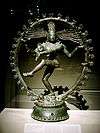Kottiyoor Vysakha Mahotsavam
| Kottiyoor Vysakha Mahotsavam | |
|---|---|
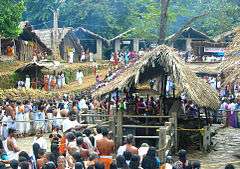 Kottiyoor Yajna bhoomi | |
| Official name | Vysakha Mahotsavam |
| Also called | Kottiyoor Utsavam |
| Observed by | Hindu |
| Type | Religious |
| Observances | Circumambulation of the Swayambhu linga through the sacred pond (Thiruvanchira) |
| Begins | Swati in Saka Calendar:Vaisakha; (Gregorian Calendar: May–June) |
| Ends | Chitra in Saka Calendar:Jyaistha; (Gregorian Calendar:June–July) |
| 2016 date | 20 May - 16 June |
| Related to | Daksha Yaga |
Kottiyoor Ulsavam or Kottiyoor Vysakha Mahotsavam (Sanskrit: वैशाख महोत्सव) is a 27-day annual pilgrimage observed by Hindus commemorating the Mythology of Daksha Yaga.[1] The pilgrimage is similar to the Kumbh Mela of Prayag, where ablutions are performed. The Vysakha Mahotsavam is a yearly pilgrimage like the Hindus' Sabarimala Pilgrimage or the Muslims' Hajj Pilgrimage, where devotees, travelling from multiple locations, go en masse to a shrine at a specific period of time during the year. The temple and grounds are also known as Dakshina Kasi.
In Kottiyoor (Kerala), there are two shrines on the banks of the Vavali (Bavali) river. On the west bank sits the Thruchherumana Vadakkeshwaram Temple (called Ikkare Kottiyoor Temple by natives), which is a nalukettu temple complex. On the east bank, there is a temporary shrine called "Akkare Kottiyoor", where the festival ceremonies take place. This is opened only during the Vysakha Mahotsavam. During the Vysakha pilgrimage, puja is performed in a temporary temple (Ikkare Kottiyoor) in the same prehistoric Vedic location. Only temporary thatch huts, which are removed after the festival, are built. Every year, thousands of pilgrims[2] come to the Yajna bhoomi.[3] Yajna shala has a Swayambhu Shivalinga, where ablutions are performed. The Akkare Kottiyoor temple, where the yajna takes place, has no Sreekovil/Garbhagriha(Sanctum-sanctorium); instead, it is located on a raised platform made of river stones named Manithara (മണിത്തറ). The temple is located at the center of a pond that is the origin of a spring. From the pond, water flows towards the Vavali river to the west. The entire shrine looks like Shivalinga itself if viewed from the sky. This pond is called Thiruvanchira(തിരുവഞ്ചിറ). Devotees circumambulate the shrine within the pond, mostly in the rain. There is another raised circular platform beside the main shrine, called Ammarakal Thara(അമ്മാരക്കല്ല് തറ). Finally, there is a giant Jayanti vilakku (a type of Lakshmi lamp) and an idol covered by a palmyra leaf umbrella (ഓലക്കുട) there. It is believed that Sati immolates herself on Ammarakal Thara.[4]

The Ikkare Kottiyoor temple and Akkare Kottiyoor temple are dedicated to Mahadeva. The Vavali River flows between the shrines. The Ikkare Kottiyoor temple is believed to have been created by Parashurama, whereas the Akkara Kottiyoor temple is a Swayam bhu, which means naturally formed. The system of rites and rituals of the temple were developed by Sankaracharya.
Period of pilgrimage
The festival occurs from the Swati Nakshatra of the Saka calendar month of Vaisakha to Chitra Nakshatra of Jyaistha month. This is equivalent to the Malayalam calendar months of Medam-Edavam to Edavam-Mithunam or the Gregorian months of May–June to June–July. The pilgrimage occurs during the monsoon season when there is abundant rainfall in the region. The flow of the Vavali river water is suitable for ablutions and the sacred pond Tiruvanchira is filled with water. The climate during the pilgrimage is moderate to slightly cold.[5]
Even though the pilgrimage is called Kottiyoor Ulsavam or Kottiyoor Festival, the programs related to the pilgrimage are only religious rituals there are no entertainment programs like festivals in other temples. Only Vedic hymns are recited and priestly rites and rituals performed.
Mythology
Daksha Yagna was an important turning point in the creation and development of sects in Hinduism like Shaktism and Shaivism. It is the story behind the 'Stala Purana' (Origin story of Temples) of Shakti Peethas.

Daksha organised a huge yaga and intentionally avoided Shiva and Sati. Even though discouraged by Shiva, who told her not to go to a function where she and her husband was uninvited; the personal bondage with her parents made Sati ignore social etiquette and her husband's wishes. Sati without Shiva went to the ceremony. She was snubbed by Daksha and insulted by him in front of the guests. Sati unable to bear further insult ran into the Sacrificial fire and immolated herself. Shiva upon knowing the terrible incident in his wrath invoked Virabhadra and Bhadrakali by plucking a lock of hair and thrashing it on the ground. Virabhadra and Bhoota ganas marched south and destroyed all the premises. Daksha was decapitated and the yagnja shaala was devastated in the rampage. The Bhutaganas' celebrated victory by plucking the beard of 'Presiding Master' of the yagnja, Sage Bhrigu as a war souvenir. Daksha was later forgiven and given life by fixing a ram (Male Goat)'s head and the yagna was allowed to complete, with the presence of all the divinity.
The story continues by the act of Vishnu in pacifying Shiva, who was in deep grief in seeing the half burned corpse of his beloved wife. Vishnu embraced Shiva to pacify him. Shiva unable to part with Sati took her corpse and wandered. The body parts of the corpse of Sati Devi fell in the places Shiva travelled. The places where the body parts Sati Devi's corpse fell came to be known as Shakti Peethas.[6][7]
Vaishakha Festival rituals
The Kottiyoor Vysakha Mahotsavam (Malayalam: കൊട്ടിയൂർ വൈശാഖ മഹോത്സവം) (Tamil: கோட்டியூர் வைசாக மகோற்சவம்)(Hindi: कोट्टीयुर वैशाख महोत्सव) festival rites are performed by akkare Kottiyoor temple on the east side of Vavali river.[8]
Kottiyoor Ulsavam is conducted in the Tiruvanchira pond in rainy season where only hay thatched huts are allowed. The sacred pond is a spring and a tributory of the Vavali river and is an appealing environment - a reminder of ancient vedic times.Kottiyoor itself is a serene hilly area. It is believed that Bhutaganas brings the materials needed for the rituals from the Tirunelli MahaVishnu Temple (10 km south of Kottiyoor Temple) through the Brahmagiri valley. Kottiyoor Temple, as its name implies, is the meeting of the Trimurti - Brahma, Vishnu and Shiva. The Shivalinga of the Kottiyoor Temple is Swayambhu i.e. formed naturally. Kottiyoor Temple pilgrimage is a rarity where each community is given right to perform specific rituals and duties for their pilgrimage.
The ceremonies for the Kottiyoou Festival, performed in sequential order, are

PurakkuvamMalayalam: പുരക്കുവം(പ്രാക്കുഴം, NeerezhunnallathuMalayalam: നീരെഴുന്നെള്ളത്, VavalikettuMalayalam: വാവലിക്കെട്ട്, Neyyattam Malayalam: നെയ്യാട്ടം, Bringing Agni and Ooda (Reed)Malayalam: ഓടയും അഗ്നിയും എഴുന്നെള്ളത്, "Vaal” EzhunnallathuMalayalam: വാൾ എഴുന്നള്ളത്, “Chothi Vilakku”Malayalam: ചോതിവിളക്ക്, “Naallam Thurakkal” Malayalam: നാളം തുറക്കൽ, “Bhandaram Ezhunnallathu” Malayalam: ഭണ്ഡാരം എഴുന്നെള്ളത്, Thiruvona Aaraadhana Malayalam: തിരുവോണ ആരാധന, Ilaneervaipu Malayalam: ഇളനീർ വെയ്പ്പ്, Ilaneerattam Malayalam: ഇളനീരാട്ടം, Revathi Aaraadhana Malayalam: രേവതി ആരാധന, Rohini Aaraadhana Malayalam: രോഹിണി ആരാധന, Thrikur Ariyalavu Malayalam: തൃക്കൂർ അരി അളവ്, Makam Malayalam: മകം, Kalam Varavu Malayalam: കളം വരവ്, Atham naal Malayalam: അത്തം നാൾ, Vallattom Malayalam: വാളാട്ടം, Thengaeru Malayalam: തേങ്ങ ഏറു, Chithra naal Malayalam: ചിത്ര നാൾ, Thrikkaleshattam Malayalam: തൃക്കലശാട്ടം, Thandilmeil Oonu Malayalam: തണ്ടിന്മേൽ ഒന്നു, Vaal madakkam Malayalam: വാൾ മടക്കം, Valiya Vattalam Payasam Malayalam: വലിയ വട്ടളം പായസം, Purakkuvam (Prakuzham, Purakuzham)Malayalam: പുരക്കുവം (പ്രാക്കുഴം, പുരക്കുഴം)
Rohini aradhana is an important ceremony. Kurumathoor Nayikan Brahman, the title of the head of a Vaishnavite family in the area, who has the birthright for the ceremony, performs the rite. He is considered a representation of Vishnu. The Namboothiri performs the rites and embraces the Swayambhu Shivalinga, i.e. Alingana Pushpanjali. This commemorates the incident which took place during the Daksha yaga. Shiva was in heartbreaking sorrow, when he saw the burned dead body of his beloved wife Sati. Rohini aradhana, is a reminder of how Vishnu embraced Shiva to pacify and comfort his dear mate.
Entry of Parashurama
Ages after the dreadful incident and havoc, carrying Sati Devi's tears and curse, the land started being governed by Kali (the personification of Kali Yuga, the reigning power of calamity). Kerala was submerged under water. Parashurama, who donated all his conquered land to Brahmins, needed a place to live. At the request of Varuna, he threw his axe from Gokarna to Kanyakumari and Kerala reemerged from the sea. Parashurama was attacked by Kali in Kottiyoor. He overpowered Kali and, as he raised his axe to kill him, the Trimurti materialised there and stopped Parashurama. He released Kali on the condition that he would never ever come into the premises of the swyam bhuu linga of his Guru, Shiva, in Kottiyoor. He started the twenty-seven-day festival to remember the incidents that happened in the place.[9]
Exclusiveness in rites
- Usha pooja is only for twenty-four days to match with the standard yaga period. However the rest of the pooja is conducted for all twenty-seven days.
- The quantity of Nivedyam is fixed as in ancient time. It not increased proportional to an increase in the number of pilgrims.
- No pooja is performed at Ammarakkal (Sati Devi's suicide site) only Pushpanjali and Nivedyam is offered.
- Punyaham is never performed, as the location is blessed with the congruence of the Shaiva, Shakta, Vaishnava divinities. Kottiyoor is so pure that all impurities are washed away. The location is the origin of a spring which form part of the Vavali River. The festival takes place during the rainy season.
- Ganapathi Homam is performed every day in morning.
- The whole premises is a temporary shelter and it is a replica of the ancient Vedic worship and culture, thousands of years ago. Unlike most pilgrimage sites there is no permanent temple structure. The pradakshinam (circumambualtion)is through a pond.

Access
The national highway passes through Kannur town. Mangalore and Mumbai can be accessed on the northern side and Cochin and Thiruvananthapuram can be accessed on the southern side. The road to the east of Iritty connects to Mysore and Bangalore. The nearest railway station is Kannur on Mangalore-Palakkad line. There are airports at Mangalore and Calicut.
Image gallery
- Festival Time
- Ikkare Kottiyur
 Entry to Akkare
Entry to Akkare Bamboo Flower Maker
Bamboo Flower Maker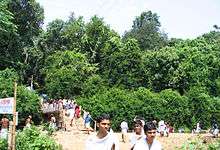 The Temple Bridge
The Temple Bridge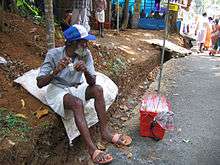 Bubble Maker
Bubble Maker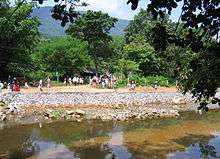 Going to Akkare Kottiyur
Going to Akkare Kottiyur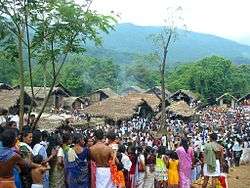 festival view
festival view- Bringing Tender Coconuts
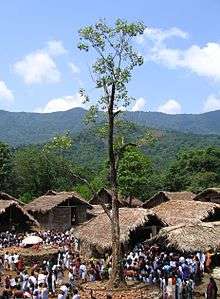 The Bunyan Tree
The Bunyan Tree
See also
- Virabhadra-Daksha
- Shaivism-Shaktism
- Shiva-Sati-Shakti Peethas
- Kottiyoor, Thalassery, Kerala
- Kottiyoor Vadakkeshwaram Temple-Tirunelli Temple
References
| Wikisource has original text related to this article: |
- ↑ "Daksha Yagnam". The Hindu. Aug 19, 2009. Retrieved 2013-07-20.
- ↑ "Thousands throng Kottiyur temple". The Hindu. Jun 7, 2005. Retrieved 19 August 2013.
- ↑ "Huge crowd at Kottiyur temple". The Hindu. Jun 17, 2006. Retrieved 19 August 2013.
- ↑ "Few Facts about the temple". Kottiyoor Devaswom. Retrieved 11 August 2013.
- ↑ "Kottiyoor Shiva Temple". touristplaces.org. Retrieved 13 August 2013.
- ↑ the Horse-sacrifice of the Prajapati Daksha The Mahabharata translated by Kisari Mohan Ganguli (1883–1896), Book 12: Santi Parva: Mokshadharma Parva: Section CCLXXXIV. p. 317. “I am known by the name of Virabhadra’’ and I have sprung from the wrath of Rudra. This lady (who is my companion), and who is called Bhadrakali, hath sprung from the wrath of the goddess.”
- ↑ http://www.hindu.com/2006/06/17/stories/2006061708850500.htm
- ↑ "Kottiyoor Devaswam Temple Administration Portal". Kottiyoordevaswom.com. Retrieved 20 July 2013.
- ↑ "Parashurama’s entry". Kottiyoordevaswom.com. Retrieved 11 August 2013.
Bibliography of notable offline sources
- Ancient Indian Tradition and Mythology: Mahapuranas-The Vayu Purana. UNESCO Heritage Publishing, (United Nations Organization). 1987. ISBN 9231030175.
- (Translator), H.H Wilson (November 4, 2008). The Vishnu Purana - Vol I. Hesperides Press. ISBN 1443722634.
- Ramesh Menon (2011). Siva: The Siva Purana Retold (1, Fourth Re-print ed.). Rupa and Co. ISBN 812911495X.
- (Translator), F. Max Muller (July 26, 2004). The Upanishads Part II: The Sacred Books of the East Part Fifteen. Kessinger Publishing, LLC. ISBN 1417930160.
- (Translator), Swami Vijnanananda (2007). The Srimad Devi Bhagavatam. Munshiram Maniharlal. ISBN 8121505917.
- Dallapiccola, Anna L (2002). Dictionary of Hindu Lore and Legend. Thames & Hudson. ISBN 0500510881.
Further reading
- (Translator), H.H Wilson (January 31, 2003). Select Works Of Sri Sankaracharya: Sanskrit Text And English Translation. Cosmo Publishing. ISBN 8177557459.
- (Translator), F. Max Muller (June 1, 2004). The Upanishads, Vol I. Kessinger Publishing, LLC. ISBN 1419186418.
External links
| Wikimedia Commons has media related to Kottiyoor Vysakha Mahotsavam. |

